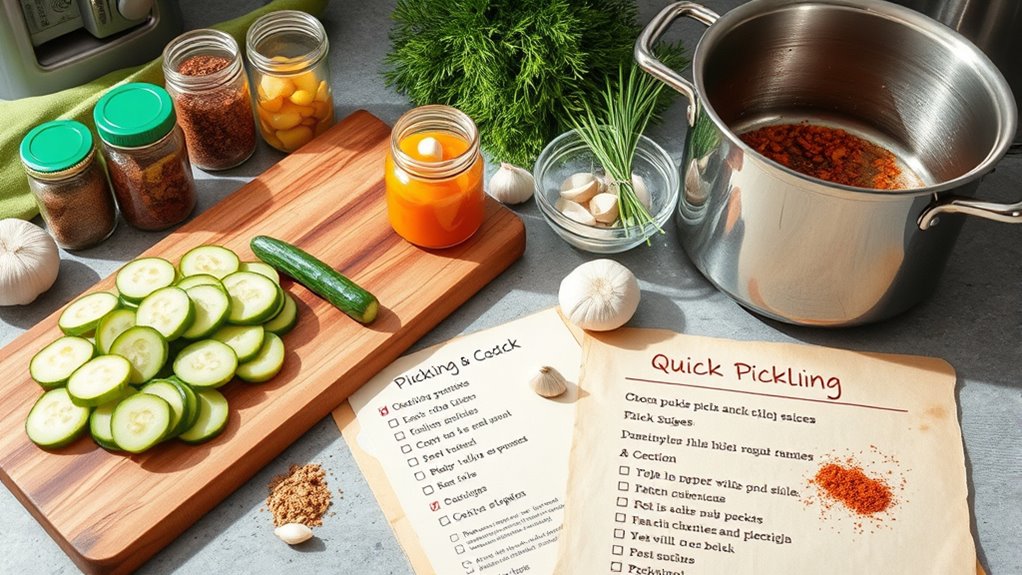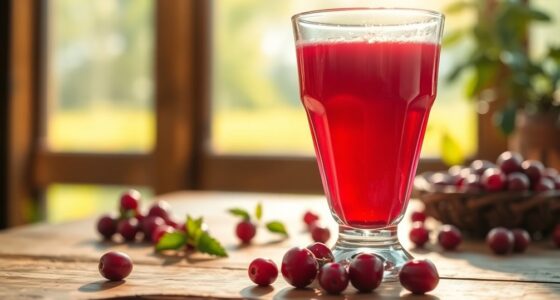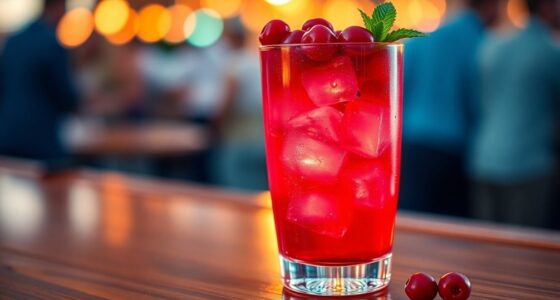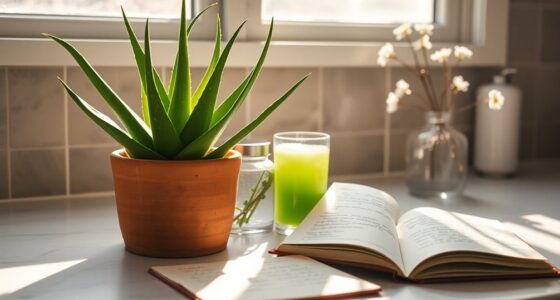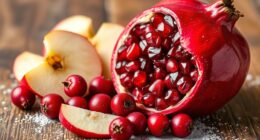To master quick pickling, gather clean jars, vinegar (white, apple cider, or rice), water, sugar, salt, and spices like dill or garlic. Choose fresh, firm produce and wash thoroughly before slicing evenly. Mix your brine and customize flavors with herbs and spices. Store jars in a cool, dark spot, and check for spoilage signs regularly. Proper safety and storage guarantee your pickles last; you’ll discover more tips ahead to perfect your process.
Key Takeaways
- Gather clean jars, vinegar, water, salt, sugar, and spices like dill and garlic for quick pickling.
- Select fresh, firm produce; wash thoroughly; cut into uniform pieces for even flavor absorption.
- Combine vinegar, water, sugar, salt, and spices to create a customizable brine recipe.
- Store jars in a cool, dark place; check for spoilage signs like mold, cloudiness, or off-odor before eating.
- Use sterilized jars and proper acidity levels to ensure safety and maximize shelf life.
Essential Ingredients and Supplies
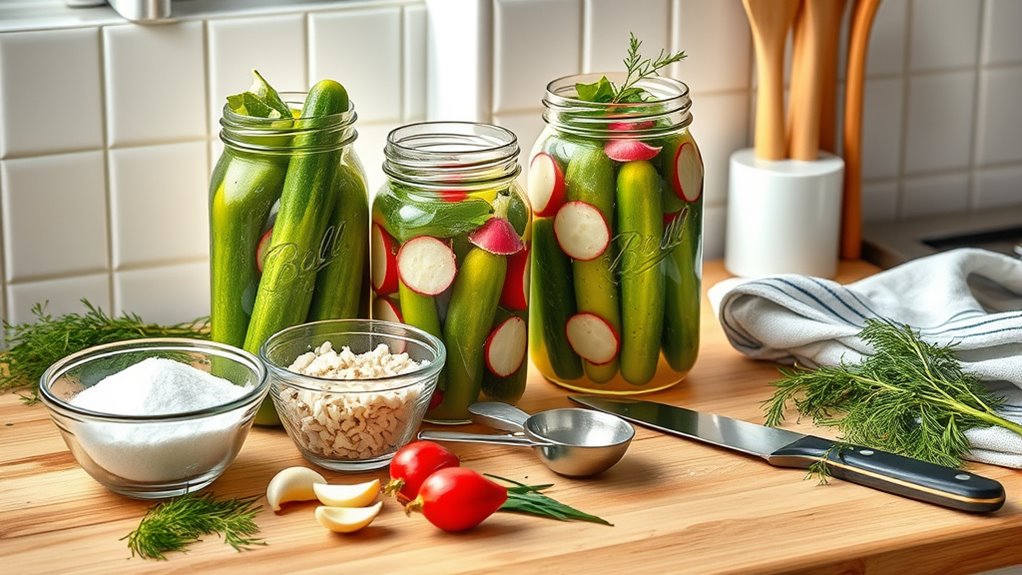
To start your quick pickling process, gather the essential ingredients and supplies. Understanding pickling history can inspire your flavor pairings, blending tradition with creativity. You’ll need vinegar—white, apple cider, or rice work well—and water to create the brine. Sugar and salt balance the acidity, enhancing your pickles’ taste. Spices like dill, garlic, peppercorns, or mustard seeds add depth, reflecting classic flavor pairings. Use clean jars or containers with tight-fitting lids for storage. A sharp knife and cutting board help prepare produce efficiently. A saucepan for heating the brine guarantees safety and proper infusion. Having these ingredients ready ensures a smooth process, allowing you to enjoy flavorful, crunchy pickles infused with history and perfect pairings in no time.
Selecting and Preparing Your Produce
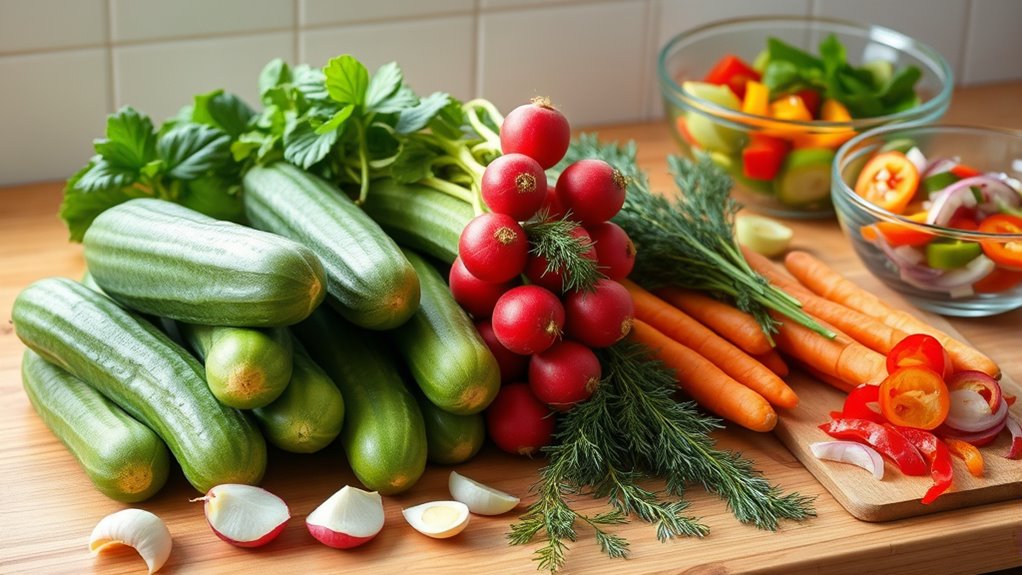
Start by choosing fresh, firm produce free of blemishes or soft spots. Wash each item thoroughly to remove dirt and any residues, then cut them into uniform pieces for even pickling. Proper preparation guarantees your vegetables stay crisp and flavorful throughout the process. Additionally, selecting produce with consistent size and shape helps ensure uniform pickling results.
Choosing Fresh Ingredients
Choosing the freshest ingredients is essential for successful pickling. Start by selecting seasonal produce, which tends to be at its peak flavor and crunch. Fresh vegetables and fruits will guarantee your pickles turn out crisp and vibrant. Whenever possible, opt for organic options—they’re free from pesticides and chemicals, making your pickles healthier and tastier. Look for produce with firm, unblemished skin and bright coloration. Avoid anything wilted, soft, or with blemishes, as these can affect texture and shelf life. Always choose ingredients that are in season; they’re more likely to be fresh and affordable. Additionally, proper sourcing and handling of ingredients ensure the best flavor and longevity for your pickles. By starting with high-quality, fresh produce, you set a solid foundation for delicious, crisp quick pickles that will last longer and taste better.
Properly Washing and Cutting
Before you begin cutting and preparing your produce, it’s important to thoroughly wash each item to remove dirt, pesticides, and bacteria. Use cool water and gently scrub with your hands or a brush. This step guarantees your pickles stay fresh and safe. When it’s time to cut, practice proper knife safety—always keep your fingers tucked and use a sharp knife to prevent slips. Employ effective cutting techniques, such as slicing evenly to ensure consistent pickling. Remove stems, seeds, and any damaged parts for better flavor and texture. Take your time with each cut, staying mindful of your hand placement. Proper washing and careful cutting set the foundation for successful quick pickling and delicious results. Incorporating mindful sound vibrations into your preparation routine can also help you stay focused and relaxed during the process.
Basic Quick Pickling Recipes and Variations
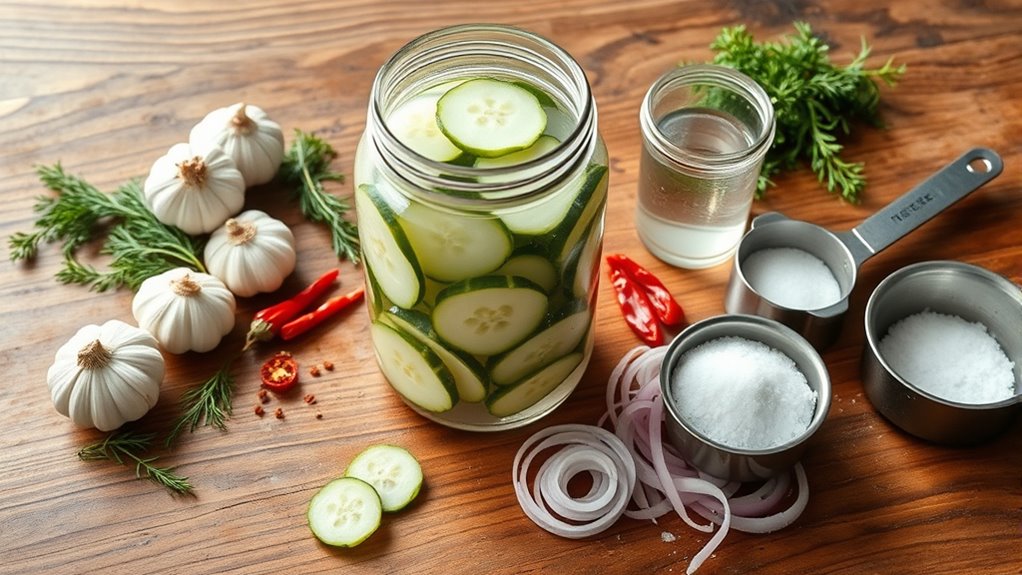
Quick pickling is an easy way to preserve vegetables and add tangy flavor to your meals, and mastering a few basic recipes can set you up for endless variations. When exploring recipes, you’ll notice a difference between fermentation vs. pickling; fermentation uses natural bacteria, while quick pickling relies on vinegar for fast results. Traditional pickling involves lengthy fermentation, often taking weeks, whereas quick pickling offers speedy, satisfying options. For simple recipes, combine vinegar, water, sugar, and salt, then add your vegetables—cucumbers, carrots, onions, or peppers—for immediate crunch. Variations include adding spices like dill, garlic, or chili flakes to customize flavor. With these foundational recipes, you can experiment endlessly, creating delicious, tangy preserves in a fraction of the time traditional methods require. Additionally, understanding Gold IRA Rollovers can help diversify your retirement portfolio, which is an important consideration when planning for long-term financial stability.
Step-by-Step Quick Pickling Process
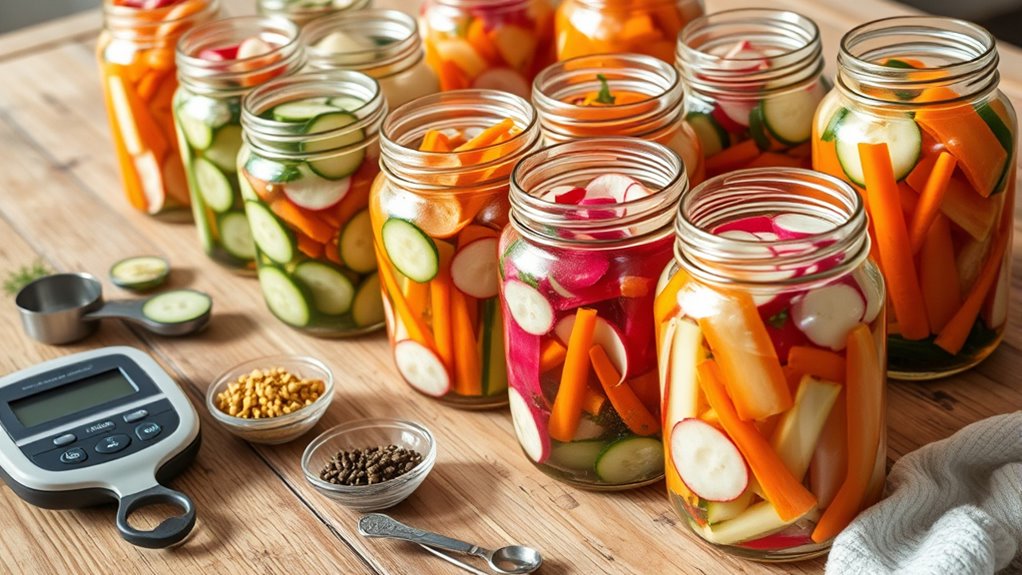
To start your quick pickling process, gather your ingredients and prepare your vegetables by washing and slicing them into uniform pieces for even flavor absorption. Quick pickling differs from fermentation in that it uses vinegar for immediate flavor rather than relying on natural fermentation. Here’s how to do it:
- Combine vinegar, water, salt, and sugar in a pot and bring to a boil to create your brine.
- Pack your vegetables tightly into sterilized jars, adding spices or herbs if desired.
- Pour the hot brine over the vegetables, ensuring they’re fully submerged, then seal the jars.
- Use a high-quality juicer to maximize the extraction of nutrients if you’re preparing fresh juice to enhance flavor and health benefits.
This method offers a fast alternative to traditional pickling, which involves fermentation over days or weeks. Quick pickling provides crisp, flavorful results without the lengthy process of fermentation vs. pickling.
Recommended Storage and Shelf Life
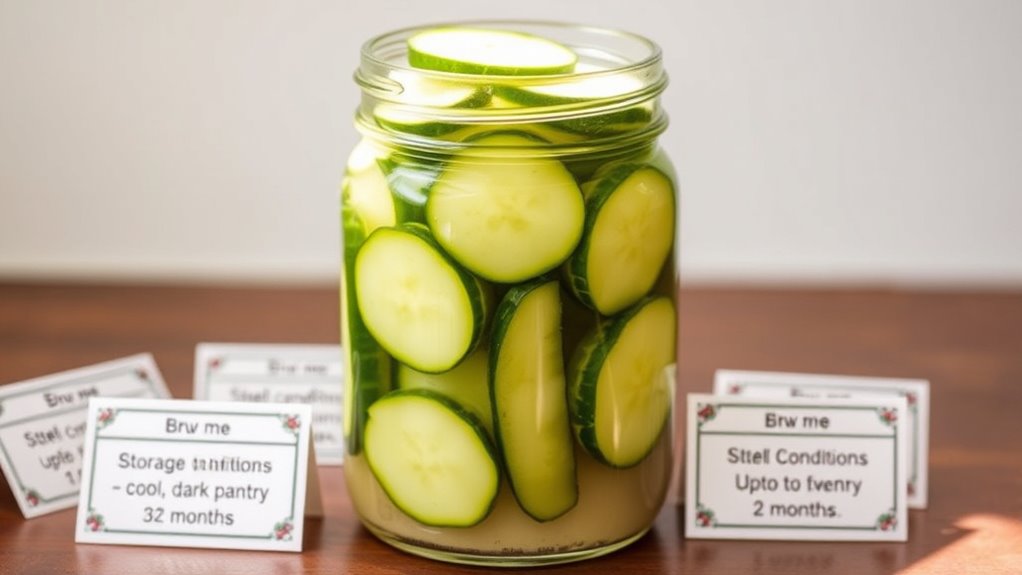
To keep your quick pickles fresh and safe, it’s important to store them in a cool, dark place away from direct sunlight. Follow recommended shelf life guidelines to guarantee they stay crisp and flavorful. Proper storage conditions can extend their shelf life and preserve their quality. Additionally, considering celebrity-inspired lifestyle insights can inspire you to create a personalized and stylish storage space.
Proper Storage Conditions
Proper storage is essential to guarantee your pickled items stay fresh and safe to eat. Maintaining the correct storage conditions helps ensure fermentation safety and preserves flavor. First, store your jars in a cool, dark place, ideally between 50-70°F (10-21°C), to prevent spoilage caused by high temperatures. Second, keep the jars upright to avoid leaks and contamination. Third, check periodically for signs of spoilage, such as cloudiness or off-odor, and discard compromised jars immediately. Proper storage temperature minimizes risks of bacterial growth, ensuring fermentation safety. Additionally, automation in business technologies can help monitor storage conditions more effectively to maintain optimal environments. Avoid storing pickles in direct sunlight or warm areas, which can compromise their quality and safety. By following these guidelines, you’ll extend shelf life and enjoy your quick pickled goodies safely.
Shelf Life Guidelines
Understanding the recommended storage and shelf life of your pickled items guarantees they remain safe and flavorful over time. Unlike fermentation, which involves natural bacteria and can develop complex flavors over weeks or months, quick pickling relies on vinegar and shorter storage. Knowing the difference between shelf life vs. spoilage helps ensure you enjoy your pickles safely. Typically, unopened jars stored in a cool, dark place last up to a year, while opened jars should be refrigerated and consumed within 1-3 months. Properly sealed and stored, your quick pickles stay fresh longer. Regularly inspecting your jars for security vulnerabilities and signs of spoilage can prevent potential health risks. Always check for signs of spoilage, such as off odors or mold, regardless of the indicated shelf life. Following these guidelines keeps your pickled creations safe and delicious for as long as possible.
Tips for Customizing Flavors
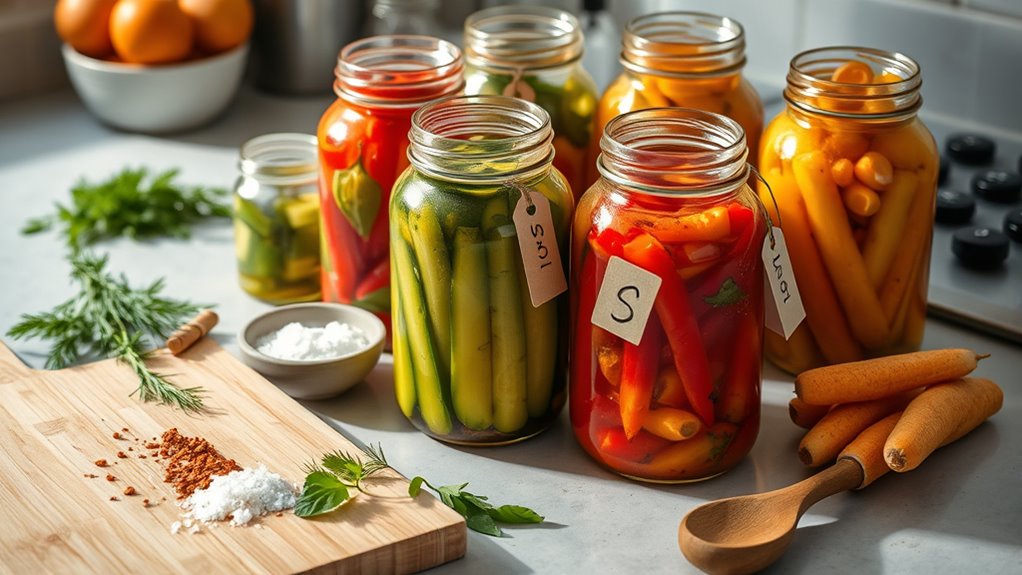
Ever wonder how to tailor pickled flavors to suit your taste? Customizing your pickles is easy and fun. First, experiment with flavor combinations like herbs, garlic, or chili peppers to create unique profiles. Second, make spice adjustments by adding more or less of ingredients like peppercorns, mustard seeds, or red pepper flakes to control heat and pungency. Third, try blending different vinegar types—apple cider, white, or rice vinegar—to influence the tanginess and depth of flavor. These small tweaks let you craft pickles that match your preferences perfectly. Additionally, understanding the acidic environment of pickling helps ensure safety and shelf stability. Remember, balancing flavor combinations and spice adjustments is key to achieving delicious, personalized pickles that stand out. Feel free to get creative and make each batch your own!
Safety Tips and Troubleshooting

When customizing flavors, it’s easy to get creative, but pickling safety should always come first. To guarantee safe results, use sterilized jars and fresh ingredients, and follow proper acidity levels to prevent spoilage. Always check for signs of mold, off-smells, or discoloration before consuming. Troubleshooting tips include adjusting the brine concentration if your pickles turn out too soft or too salty. If your jars don’t seal properly, refrigerate and consume promptly. Avoid using expired or damaged produce, as this can compromise safety. Remember, proper storage is key—keep jars in a cool, dark place. Additionally, selecting safe, durable wooden toys can promote safe play environments for children during your kitchen activities. Staying vigilant with pickling safety helps prevent foodborne illnesses and guarantees delicious, safe pickles every time.
Frequently Asked Questions
Can I Reuse Pickling Brine for Multiple Batches?
You can reuse brine for multiple batches, but only if you prioritize brine safety. Reusing brine may introduce bacteria or spoilage, so make sure to boil it thoroughly before reusing. Also, check for any signs of mold or off-odor. If the brine has become cloudy or shows any signs of spoilage, discard it. Maintaining proper sanitation guarantees your pickles stay safe and delicious.
How Do I Adjust Pickling Recipes for Different Vegetables?
Think of your pickling recipe as a musical score—each vegetable has its unique melody. To adjust, match the vegetable’s flavor profile by tweaking spices and vinegar strength, and modify texture by altering brine time. For crisper carrots, extend the soak; for softer cucumbers, reduce it. By tuning these elements, you create a harmonious balance that highlights each vegetable’s natural flavor and desired crunch.
Are There Low-Sodium or Salt-Free Quick Pickling Options?
Yes, you can find low-sodium alternatives and salt-free recipes for quick pickling. You might use herbs, spices, and vinegar to enhance flavor without salt. Look for recipes that emphasize acidity and aromatic ingredients to compensate for reduced salt. Experimenting with these options allows you to enjoy delicious, healthier pickles while controlling your sodium intake. Just guarantee your pickling solution maintains proper acidity for safety and flavor.
What Are Signs of Spoilage in Quick Pickled Vegetables?
Think of your quick pickled vegetables as tiny sentinels—if you notice mold development or a foul odor, it’s time to say goodbye. These are clear signs of spoilage, indicating bacteria or mold have taken hold. Trust your senses; if it looks off or smells bad, don’t take chances. Discard the vegetables immediately to keep your kitchen safe and your taste buds happy.
Can I Make Quick Pickles Without Vinegar?
You can make quick pickles without vinegar by exploring alternative liquids like lemon juice, lime juice, or brine from other fermented foods. These options provide acidity for preservation and add unique flavor variations. Keep in mind, using non-vinegar liquids may alter the taste and shelf life, so guarantee proper storage and refrigeration. Experimenting with different acids can give your quick pickles a custom flavor profile while maintaining safety.
Conclusion
Now that you’re armed with this complete checklist, quick pickling becomes as easy as pie. Think of it as turning your kitchen into a treasure chest of tangy delights, ready to brighten any meal. With a little practice, you’ll master the art of quick pickling, transforming everyday produce into vibrant, flavorful treasures. So go ahead—dive in and let your creativity ferment into delicious, crunchy creations that’ll make your taste buds sing!
Susannah expertise lies in researching and compiling evidence-based content on juicing, nutrition, and overall health. She is committed to ensuring that The Juicery World offers accurate, up-to-date, and trustworthy information to empower readers to take control of their health. Susannah’s goal is to inspire individuals to embrace juicing as a way to nourish their bodies and live their best lives.

